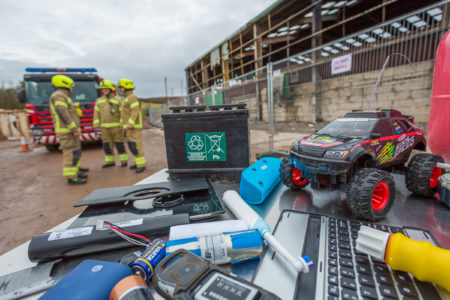Sector-led guidance is being drafted to assist waste management companies in handling lithium ion batteries to prevent fires at waste sites.
Both the Environmental Services Association (ESA) and the AATF (Approved Authorised Treatment Facility) Forum – which represents treatment facility operators in the WEEE sector – are working on projects to reduce the risk of fires linked to Li-Ion batteries at their members’ sites.

Lithium ion batteries are contained in a number of household products
Lithium ion batteries are commonly found in consumer IT and electronics products. While accidents are rare when these batteries are used by consumers, handling at the end of life, particularly if the battery gets punctured, can lead to fires by igniting other combustible waste.
ESA – which represents the UK’s waste management sector – has identified the issue as a particular concern to its members and is currently finalising guidance on the identification and handling of batteries at waste sites.
According to the organisation, of the 510 fires reported by its members across the UK in 2017-18, a quarter (25%) were attributed to Li-Ion batteries.
Risk
Stephen Freeland, policy advisor at ESA, told letsrecycle.com that waste companies are particularly exposed to risk when a battery is collected within dry mixed recycling (DMR) waste – and can be damaged in sorting machinery – or within residual waste.
He explained that ESA’s guidance will focus on areas including identifying batteries within mixed loads at the point of collection, effective segregation once batteries are found, recycling routes and proper disposal, as well as identifying areas in a facility where there is a particular risk of fire.
Mr Freeland, said: “The main updates are to develop some good practice guidance on what to do when a battery turns up on site.
“The problem we are having is when people improperly dispose of Lithium Ion batteries, either in DMR or black bag waste.”
WISH
A first draft of the ESA’s guidance document – which has been drafted by the organisation’s Hazardous Waste Working Group – is currently being reviewed by the Waste Industry Safety & Health Forum (WISH) – and it is expected that a full version will be available later in 2019.
WISH Forum chair Chris Jones, said: “Lithium ion batteries are one of the initiators of fires – but we need not to think that if we stop the lithium ion battery problem, fires will go away.
“Lithium ion batteries are one of the initiators of fires – but we need not to think that if we stop the lithium ion battery problem, fires will go away.”
Chris Jones
WISH Forum
“There has been analysis that a third of fires have batteries as an initiator. But, whether they are the initiator of large fires is another question entirely.”
Commenting on the industry-developed guidance, he said: “I have seen a first draft of the guidance and I think it is a useful document.
“The batteries that we spot and segregate are not the issue, but the ones that are contained in the waste are. We have to find a way of dealing with the fire initiation potential of these batteries as well as encouraging better education, storage and segregation.”
AATF Forum
WEEE reprocessors have also identified Li-Ion batteries as a major fire risk – particularly in the processing of small mixed WEEE.
The Approved Authorised Treatment Facility (AATF) Forum – which represents the operators of WEEE facilities in the UK is looking to bring forward some proposals to improve the separation of batteries from local authority-collected waste.
Commenting on the work, Phil Conran, chair of the AATF Forum, said: “We have agreed to set up a project group to look at how we can put proposals to the Environment Agency and look at possible measures to local authorities to prevent Li-On batteries getting into the waste stream in the first place.”
He added: “The question we will have to look at is how practical is it to look at measures to take Li-Ion batteries out. What measures could be put in to try and predict for the damage they can cause?
“Along with all the other problems we have got at the moment we have increasing problems in how we manage the movement and treatment of WEEE.”
SAFeRWEEE
Alongside this, a cross-industry project is being carried out in Merseyside – funded through the WEEE producer compliance fee – to look at the practical challenges involved in separating batteries at HWRC sites.

SAFeRWEEE will look at encouraging separation of items with batteries at HWRCs
‘SAFeRWEEE’ involves partners Axion Consulting, Viridor, Veolia, S Norton, Wastecare and Mersey Fire to address the risk of fire by demonstrating a collection protocol for the material.
From the summer, householders at three Merseyside household waste recycling centres will be asked to segregate small mixed WEEE into three streams before disposal: items not containing batteries; batteries removed from items; and, items where batteries cannot be removed.
Results from the trial will be shared in December, and it is hoped that this could form the basis of a new voluntary collection protocol for the country.
Jon Tomkins, environment manager for metal recycler S Norton, which is a partner in the project, said: “We have seen a marked increase in the number of fires involving lithium ion batteries.”
On the SAFeRWEEE project, he said: “The idea is that we make people more aware of the risk of batteries when they dispose of them.”
The post Waste industry looks to tackle Lithium-Ion battery fires appeared first on letsrecycle.com.
Source: letsrecycle.com Metal



